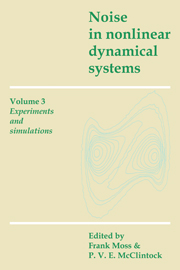Book contents
- Frontmatter
- Contents
- List of contributors
- Preface
- Introduction to Volume 3
- 1 The effects of colored quadratic noise on a turbulent transition in liquid He II
- 2 Electrohydrodynamic instability of nematic liquid crystals: growth process and influence of noise
- 3 Suppression of electrohydrodynamic instabilities by external noise
- 4 Colored noise in dye laser fluctuations
- 5 Noisy dynamics in optically bistable systems
- 6 Use of an electronic model as a guideline in experiments on transient optical bistability
- 7 Computer experiments in non-linear stochastic physics
- 8 Analogue simulations of stochastic processes by means of minimum component electronic devices
- 9 Analogue techniques for the study of problems in stochastic nonlinear dynamics
- Index
6 - Use of an electronic model as a guideline in experiments on transient optical bistability
Published online by Cambridge University Press: 05 January 2012
- Frontmatter
- Contents
- List of contributors
- Preface
- Introduction to Volume 3
- 1 The effects of colored quadratic noise on a turbulent transition in liquid He II
- 2 Electrohydrodynamic instability of nematic liquid crystals: growth process and influence of noise
- 3 Suppression of electrohydrodynamic instabilities by external noise
- 4 Colored noise in dye laser fluctuations
- 5 Noisy dynamics in optically bistable systems
- 6 Use of an electronic model as a guideline in experiments on transient optical bistability
- 7 Computer experiments in non-linear stochastic physics
- 8 Analogue simulations of stochastic processes by means of minimum component electronic devices
- 9 Analogue techniques for the study of problems in stochastic nonlinear dynamics
- Index
Summary
Introduction
The transient behavior of nonlinear optical resonators which display bistability and its reaction to fluctuations of system parameters are of extreme importance in all possible applications of these devices. Moreover, however, studies on these processes may give insight into some more general aspects of the behavior of nonlinear dynamical systems. In fact it has been emphasized in the early stages of the development of the field that optically bistable systems, in a suitable model, may exhibit a first-order phase transition (Bonifacio and Lugiato, 1978). Since the threshold behavior of a laser can be described as an example of a second-order phase transition (Haken, 1964,1975; see also Haken, 1977), optical bistability in (passive) nonlinear resonators complements nicely lasers as nonlinear dissipative systems in optics. Both types of optical systems are easily accessible to measurements, and the time scales coming into play are convenient for detailed experimental studies of the dynamics.
It is worth mentioning that there is a close connection between laser operation and optical bistability in nonlinear (passive) resonators (see Lugiato, 1984). The standard single-mode laser model with distributed losses (Haken, 1970; Sargent, Scully and Lamb, 1974) can be generalized to include the effect of an external field that continuously drives the atoms within the optical resonator. The standard model of absorptive bistability, the Bonifacio–Lugiato model, is a special case of this generalized model. It represents the situation of a pumping mechanism being absent.
- Type
- Chapter
- Information
- Noise in Nonlinear Dynamical Systems , pp. 159 - 188Publisher: Cambridge University PressPrint publication year: 1989

